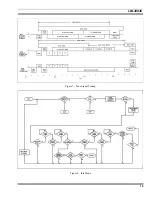
LBI-38836
18
trunking transmit band to the 851-870 MHz band. This
allows direct transmission to another portable without going
through a system repeater.
ORIGINATING A CALL
When originating a call, the portable identifies an idle
repeater channel and interrogates it with a single burst of
"busy" tone, the repeater keys its transmitter and sends a
burst of "acquisition" tone back to the portable unit. When
the interrogating portable detects the acquisition tone, it then
transmits its collect and group tones, which the repeater
regenerates for all idle portable units in the system.
The idle portables, which continually scan all channels,
will stop on the active channel if any of the programmed
collect tones are detected and wait for group tone(s).
If the correct tone sequence is detected, the portables
will alert the operator to an incoming call and open their
audio circuits. If the correct sequence is not detected, the
idle portables will resume scanning the channels. Once the
portable is "locked" on a channel, it will remain there until
the repeater times out or the operator terminates the call.
OPERATIONAL MODES
The radio will always be in one of three operational
modes; idle, wait, or ready. The three operational modes and
the conditions that cause the radio to switch from one mode
to another are shown in Figure 6.
The radio enters the idle mode when power is turned on
and begins scanning channels for incoming calls. The wait
mode is entered when the user places a call. The radio
remains in the wait mode until a channel is acquired, or if no
channel is available. The ready or conversion mode is
indicated by an alert tone. A tone signalling Timing Diagram
is shown in Figure 7. Sequence Flow Charts for each
operational mode are shown in Figures 8, 9 and 10.
Idle Mode (Figure 8)
When the radio is in the Idle Mode, the audio is muted
and all channels programmed for call decode are
sequentially scanned for an incoming call. An incoming call
is identified by detecting one of the collect tones
programmed in the area. Upon receipt of a collect tone, the
portable looks for a short interval for the group or individual
tones, providing that their collect tones are the same. When
no valid tone is found, the portable will resume scanning the
channels for an incoming call.
Figure 6 - Operational Modes
If a group (or individual decode) tone is detected the
portable then looks for busy tone for a 90 millisecond
period. If four tones are properly decoded, the portable will
then look for busy tone for 270 milliseconds.
When no valid tones are found, the portable will resume
scanning for a call with the next channel. When a busy tone
is found, the portable will enter the Ready Mode. If busy
tone is not detected, the portable remains in the Idle Mode
and continues scanning channels looking for an incoming
call. Pressing the PTT switch will cause the radio to enter
the Wait Mode.
Wait Mode (Figure 9 on page 19)
When the user enters the Wait mode, the group tone is
checked to make sure it is a valid call-originate group. It if it
not valid, a high-frequency steady tone is heard in GE-
MARC V
•
E systems only. If valid, the radio will scan the
call-originate frequencies for brief intervals until it finds one
with no busy tone on it. If no channel is free, the radio will
activate the Call Retry state if programmed for this option.
This causes the radio to revert to the Idle mode and scan for
a call while trying the Wait mode approximately every 20
seconds for a five minute period. If the Retry option is not
programmed the portable will sound a low-frequency tone,
and then return to the idle mode.





































